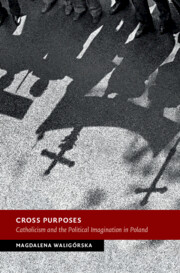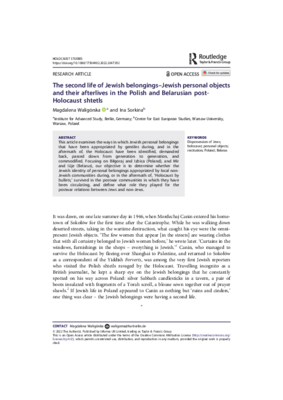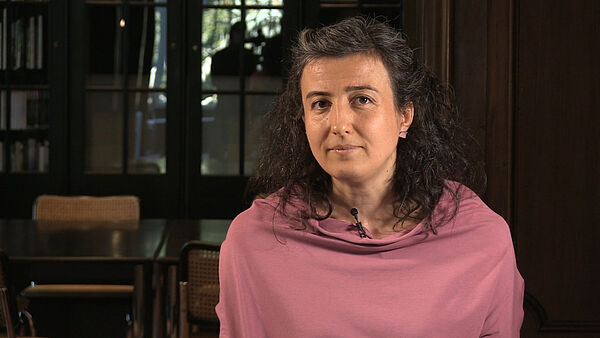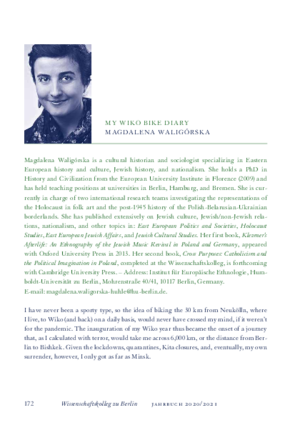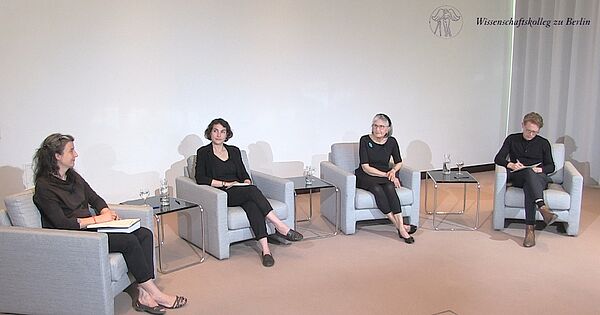
Magdalena Waligórska, Ph.D.
History
Humboldt-Universität zu Berlin
Born in 1980 in Slubice, Poland
Studied English Philology at the Jagiellonian University, Political Sociology at Dalarna University, and History and Civilization at the European University Institute
Arbeitsvorhaben
A Cultural History of the Cross in the Polish Political Imagination
No other symbol is as omnipresent in Poland as the cross. It features prominently in public spaces and state institutions; it is anchored in the country's visual history, inspires protest culture, and dominates the natural landscape itself. No other symbol is as multilayered and contradictory, either: it connotes Poland's historic struggles for independence and anti-Communist dissent, but it also stands for Poland's current position in Europe as a bulwark of Christianity and a champion of conservative values. It is both a national symbol - defining the boundary of Polishness in opposition to a changing constellation of the country's Others, be it Russians, Jews or Muslim refugees - and a key object of contestation in creative arts and political culture. Yet, despite the centrality of the symbol for Polish culture, political history and social life, a cultural history of the cross in Poland has not been written yet. Especially today, as the symbol is being hijacked by right-wing populists and inscribed into the cultural and political battles over the country's past, democratic principles, and its place in the European community, a critical reflection on the origins and development of this powerful emblem seems urgently needed.This cultural history of the cross in Poland, spanning the period from 1863 to the present, traces the changing political meanings attached to the symbol, addressing a number of broader issues, such as: 1) the performative use of religious symbols to mobilize protest and solidify state power; 2) the instrumentalization of the Catholic imaginary in modern Polish political life; 3) and the role of religious symbols as tools of exclusion and source of populist visual repertoire.
Recommended Reading
Waligórska, Magdalena, and Simon Lewis, guest eds. "Poland's Wars of Symbols." Special section, East European Politics and Societies and Cultures 33, 2 (2019).
Waligórska, Magdalena. "Remembering the Holocaust on the Fault Lines of East and West-European Memorial Cultures: The New Memorial Complex in Trastsianets, Belarus." Holocaust Studies 24, 3 (2018): 329-353.
-. Klezmer's Afterlife: An Ethnography of the Jewish Music Revival in Poland and Germany. New York: Oxford University Press, 2013.
Kolloquium, 15.09.2020
Der Aufstieg des religiösen Populismus und das Symbol des Kreuzes in den politischen Konflikten Polens heute
In diesem Vortrag beleuchte ich noch einmal die Ereignisse des Jahres 2010, als die polnische Gesellschaft vom tödlichen Flugzeugabsturz der Präsidentenmaschine in der Nähe von Smolensk erschüttert wurde; dies löste einen der wirkmächtigsten symbolischen Konflikte in der modernen Geschichte des Landes aus. Der Aufstieg des Rechtspopulismus, der auf den Smolensker Absturz folgte und die Grundlagen für den Übergang Polens zur illiberalen Demokratie in jüngster Zeit legte, fiel mit einem verstärkten Gebrauch religiöser Bildsymbolik zusammen, der schließlich die etablierten Ausdrucksweisen des Nationalstolzes und der nationalen Zugehörigkeit beherrschte. In meinem Vortrag untersuche ich die populistische Instrumentalisierung katholischer Symbole und ziehe dafür das "Smolensk-Kreuz" heran, das vor dem Präsidentenpalast in Warschau aufgestellt und sechs Monate lang von einer Gruppe von Anhängern des verstorbenen Präsidenten Kaczynski erbittert verteidigt wurde. Die "Verteidiger des Smolensk-Kreuzes", die gegen den neuen demokratisch gewählten, liberalen Präsidenten Bronislaw Komorowski protestierten, benutzten das Symbol, um einen eigentlich parteipolitischen Konflikt in einen manichäischen Kampf zwischen Gut und Böse umzudeuten. In ihrem exkludierenden Narrativ werden die liberalen Eliten Polens, ethnische und sexuelle Minderheiten als "Feinde des Kreuzes" und somit automatisch als "Feinde des Volkes" etikettiert. Gleichzeitig kaperten Laizisten, die die Anwesenheit des Kreuzes vor dem Sitz der polnischen Exekutive ablehnten, das Symbol in provokatorischer, subversiver Absicht und ermöglichten ein karnevaleskes "Gegenritual".
Publikationen aus der Fellowbibliothek
Waligórska, Magdalena (Cambridge, 2023)
Cross purposes : catholicism and the political imagination in Poland New studies in european history
Waligórska, Magdalena (Abingdon [u.a.], 2022)
Waligórska, Magdalena (Thousand Oaks, Calif., 2019)
On the genealogy of the symbol of the cross in the Polish political imagination
Waligórska, Magdalena (Thousand Oaks, Calif., 2019)
Introduction : Poland’s wars of symbols
Waligórska, Magdalena (Berlin, 2018)
Jewish translation - translating Jewishness
Waligórska, Magdalena (Abingdon [u.a.], 2017)
Waligórska, Magdalena (Oxford, 2013)
Klezmer's afterlife : an ethnography of the Jewish music revival in Poland and Germany
